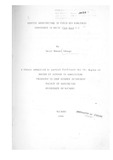Genetic architecture of yield and earliness components in maize (Zea mays L.)
Abstract
Eight parents (maize inbred lines) derived from
diverse base populations of maize were used to develop
twenty eight single crosses excluding reciprocals in a
diallel mating system.
The twenty eight single crosses and their eight
parents were tested in a randomized block design at Embu
Agricultural Research station (UMZ) and Murinduko substation
(UM4). The experiment was planted during the
long rain season 1985. The normal agronomic practices
were followed.
The main objectives were to compute the relationship
between grain yield and its components, estimation
of heterosis, combining ability, heritability and
identification of the nature of gene actions for yield
and earliness components. The data were collected on
ten randomly selected plants for ten characters namely;
number of days to 50% pollen shed, days to 50% silking,
number of leaves per plant, plant height, rows per ear,
number of kernels per row, ear length, ear weight, 100
kernel weight an~ grain yield per plant.
Statistical analysis was carried out according
to Panse and Sukhatme (1964) procedure for randomized
block design.
(xiii)
The genotypes were found to differ significantly
CP~ O.OJ) for all characters studied. The hybrids Embu
206 x Embu 107 had the highest grain yield per plant
(163.40 ~) followed by Embu 206 x Embu 108 (157.75 ~ )
at Embu Agricultural Research Station. At the Murinduko
site, the hybrid with the highest grain yield per plant
was Tx5855 x Embu 107 (148.30 g') followed by Bs l3(1a)
x Embu 108 (147.10 ~ )
Ear length and 100 kernel weight were found to be
suitable yield components to be utilized for selection
for grain yield per plant improvement. This is due to
their high correlations with grain yield per plant, high
heritability and ease of measurement of these traits.
The studies showed that earliness and grain yield
per plant were non-significantly correlated and
therefore, it was possible to select for earliness
without adversely affecting grain yield per plant.
The general and specific combining ability
findings suggested that both additive and non-additive
gene actions were responsible for the inheritance of
grain yield per plant, 100 kernel weight, ear weight,
ear length, kernels per row, leaves per plant, days to
50% pollen shed and days to 50% silking. General
combining ability contribution for plant height
expression was non-significant and for rows per ear
(xiv)
expression specific combining ability was non-significant.
The general combining ability effects of parents
were not reflected in the specific combining ability
effects of their crosses. The study indicated that the
.~ ~ performance of a parent cannot be used as a
measure of its general combining ability.
Five parents namely; Embu 107, Embu 206, Embu
204, Embu 108 and TX5855 were identified as promising
parents for hybrid development. Embu 107 had high
general combining ability at both sites (UM2 and UM4) ,
suggesting that it can be used as a parent in synthetic
development.
The number of leaves per plant was positively
and significantly correlated (P = 0.05) with the days
to 50% pollen shed and 50% silking. It has a high
narrow sense heritability and it would be a suitable
(
trait when selecting for earliness since its response
to selection is expected to be higher than when
selection is based on days to flowering.
The experimental findings suggested that combining
ability, particularly specific combining ability and
broad sense heritability were location dependent and ~~J
not be generalized.
Citation
A thesis submitted in partial fulfilment for the degree of master of science in the University of Nairobi.Publisher
Plant Science & Crop Protection, University of Nairobi

